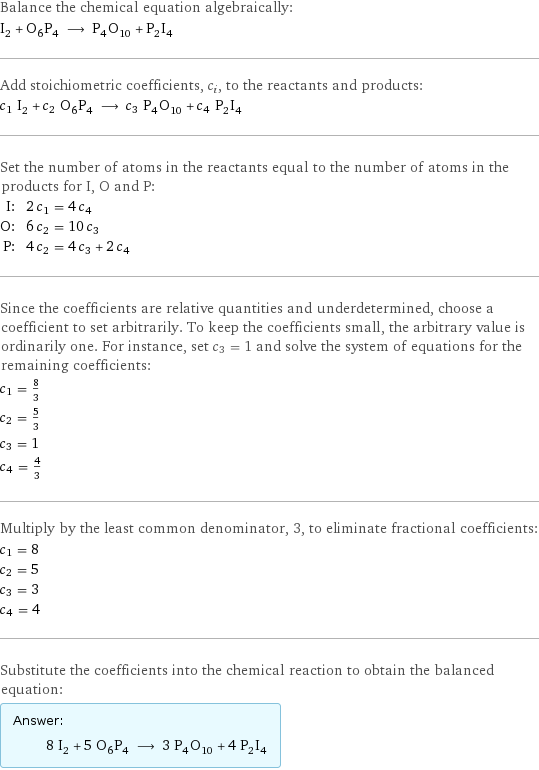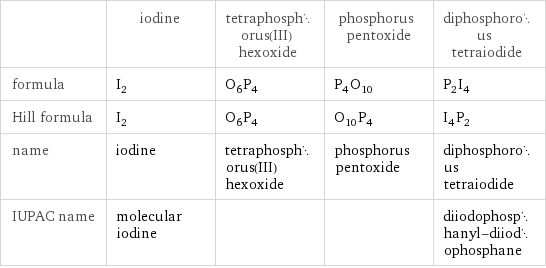Input interpretation

I_2 iodine + O_6P_4 tetraphosphorus(III) hexoxide ⟶ P_4O_10 phosphorus pentoxide + P_2I_4 diphosphorous tetraiodide
Balanced equation

Balance the chemical equation algebraically: I_2 + O_6P_4 ⟶ P_4O_10 + P_2I_4 Add stoichiometric coefficients, c_i, to the reactants and products: c_1 I_2 + c_2 O_6P_4 ⟶ c_3 P_4O_10 + c_4 P_2I_4 Set the number of atoms in the reactants equal to the number of atoms in the products for I, O and P: I: | 2 c_1 = 4 c_4 O: | 6 c_2 = 10 c_3 P: | 4 c_2 = 4 c_3 + 2 c_4 Since the coefficients are relative quantities and underdetermined, choose a coefficient to set arbitrarily. To keep the coefficients small, the arbitrary value is ordinarily one. For instance, set c_3 = 1 and solve the system of equations for the remaining coefficients: c_1 = 8/3 c_2 = 5/3 c_3 = 1 c_4 = 4/3 Multiply by the least common denominator, 3, to eliminate fractional coefficients: c_1 = 8 c_2 = 5 c_3 = 3 c_4 = 4 Substitute the coefficients into the chemical reaction to obtain the balanced equation: Answer: | | 8 I_2 + 5 O_6P_4 ⟶ 3 P_4O_10 + 4 P_2I_4
Structures

+ ⟶ +
Names

iodine + tetraphosphorus(III) hexoxide ⟶ phosphorus pentoxide + diphosphorous tetraiodide
Equilibrium constant
![Construct the equilibrium constant, K, expression for: I_2 + O_6P_4 ⟶ P_4O_10 + P_2I_4 Plan: • Balance the chemical equation. • Determine the stoichiometric numbers. • Assemble the activity expression for each chemical species. • Use the activity expressions to build the equilibrium constant expression. Write the balanced chemical equation: 8 I_2 + 5 O_6P_4 ⟶ 3 P_4O_10 + 4 P_2I_4 Assign stoichiometric numbers, ν_i, using the stoichiometric coefficients, c_i, from the balanced chemical equation in the following manner: ν_i = -c_i for reactants and ν_i = c_i for products: chemical species | c_i | ν_i I_2 | 8 | -8 O_6P_4 | 5 | -5 P_4O_10 | 3 | 3 P_2I_4 | 4 | 4 Assemble the activity expressions accounting for the state of matter and ν_i: chemical species | c_i | ν_i | activity expression I_2 | 8 | -8 | ([I2])^(-8) O_6P_4 | 5 | -5 | ([O6P4])^(-5) P_4O_10 | 3 | 3 | ([P4O10])^3 P_2I_4 | 4 | 4 | ([P2I4])^4 The equilibrium constant symbol in the concentration basis is: K_c Mulitply the activity expressions to arrive at the K_c expression: Answer: | | K_c = ([I2])^(-8) ([O6P4])^(-5) ([P4O10])^3 ([P2I4])^4 = (([P4O10])^3 ([P2I4])^4)/(([I2])^8 ([O6P4])^5)](../image_source/ca938a80d08475ddbcc54d6d747c0e1c.png)
Construct the equilibrium constant, K, expression for: I_2 + O_6P_4 ⟶ P_4O_10 + P_2I_4 Plan: • Balance the chemical equation. • Determine the stoichiometric numbers. • Assemble the activity expression for each chemical species. • Use the activity expressions to build the equilibrium constant expression. Write the balanced chemical equation: 8 I_2 + 5 O_6P_4 ⟶ 3 P_4O_10 + 4 P_2I_4 Assign stoichiometric numbers, ν_i, using the stoichiometric coefficients, c_i, from the balanced chemical equation in the following manner: ν_i = -c_i for reactants and ν_i = c_i for products: chemical species | c_i | ν_i I_2 | 8 | -8 O_6P_4 | 5 | -5 P_4O_10 | 3 | 3 P_2I_4 | 4 | 4 Assemble the activity expressions accounting for the state of matter and ν_i: chemical species | c_i | ν_i | activity expression I_2 | 8 | -8 | ([I2])^(-8) O_6P_4 | 5 | -5 | ([O6P4])^(-5) P_4O_10 | 3 | 3 | ([P4O10])^3 P_2I_4 | 4 | 4 | ([P2I4])^4 The equilibrium constant symbol in the concentration basis is: K_c Mulitply the activity expressions to arrive at the K_c expression: Answer: | | K_c = ([I2])^(-8) ([O6P4])^(-5) ([P4O10])^3 ([P2I4])^4 = (([P4O10])^3 ([P2I4])^4)/(([I2])^8 ([O6P4])^5)
Rate of reaction
![Construct the rate of reaction expression for: I_2 + O_6P_4 ⟶ P_4O_10 + P_2I_4 Plan: • Balance the chemical equation. • Determine the stoichiometric numbers. • Assemble the rate term for each chemical species. • Write the rate of reaction expression. Write the balanced chemical equation: 8 I_2 + 5 O_6P_4 ⟶ 3 P_4O_10 + 4 P_2I_4 Assign stoichiometric numbers, ν_i, using the stoichiometric coefficients, c_i, from the balanced chemical equation in the following manner: ν_i = -c_i for reactants and ν_i = c_i for products: chemical species | c_i | ν_i I_2 | 8 | -8 O_6P_4 | 5 | -5 P_4O_10 | 3 | 3 P_2I_4 | 4 | 4 The rate term for each chemical species, B_i, is 1/ν_i(Δ[B_i])/(Δt) where [B_i] is the amount concentration and t is time: chemical species | c_i | ν_i | rate term I_2 | 8 | -8 | -1/8 (Δ[I2])/(Δt) O_6P_4 | 5 | -5 | -1/5 (Δ[O6P4])/(Δt) P_4O_10 | 3 | 3 | 1/3 (Δ[P4O10])/(Δt) P_2I_4 | 4 | 4 | 1/4 (Δ[P2I4])/(Δt) (for infinitesimal rate of change, replace Δ with d) Set the rate terms equal to each other to arrive at the rate expression: Answer: | | rate = -1/8 (Δ[I2])/(Δt) = -1/5 (Δ[O6P4])/(Δt) = 1/3 (Δ[P4O10])/(Δt) = 1/4 (Δ[P2I4])/(Δt) (assuming constant volume and no accumulation of intermediates or side products)](../image_source/828184f43cfc429731103a5a6edb8420.png)
Construct the rate of reaction expression for: I_2 + O_6P_4 ⟶ P_4O_10 + P_2I_4 Plan: • Balance the chemical equation. • Determine the stoichiometric numbers. • Assemble the rate term for each chemical species. • Write the rate of reaction expression. Write the balanced chemical equation: 8 I_2 + 5 O_6P_4 ⟶ 3 P_4O_10 + 4 P_2I_4 Assign stoichiometric numbers, ν_i, using the stoichiometric coefficients, c_i, from the balanced chemical equation in the following manner: ν_i = -c_i for reactants and ν_i = c_i for products: chemical species | c_i | ν_i I_2 | 8 | -8 O_6P_4 | 5 | -5 P_4O_10 | 3 | 3 P_2I_4 | 4 | 4 The rate term for each chemical species, B_i, is 1/ν_i(Δ[B_i])/(Δt) where [B_i] is the amount concentration and t is time: chemical species | c_i | ν_i | rate term I_2 | 8 | -8 | -1/8 (Δ[I2])/(Δt) O_6P_4 | 5 | -5 | -1/5 (Δ[O6P4])/(Δt) P_4O_10 | 3 | 3 | 1/3 (Δ[P4O10])/(Δt) P_2I_4 | 4 | 4 | 1/4 (Δ[P2I4])/(Δt) (for infinitesimal rate of change, replace Δ with d) Set the rate terms equal to each other to arrive at the rate expression: Answer: | | rate = -1/8 (Δ[I2])/(Δt) = -1/5 (Δ[O6P4])/(Δt) = 1/3 (Δ[P4O10])/(Δt) = 1/4 (Δ[P2I4])/(Δt) (assuming constant volume and no accumulation of intermediates or side products)
Chemical names and formulas

| iodine | tetraphosphorus(III) hexoxide | phosphorus pentoxide | diphosphorous tetraiodide formula | I_2 | O_6P_4 | P_4O_10 | P_2I_4 Hill formula | I_2 | O_6P_4 | O_10P_4 | I_4P_2 name | iodine | tetraphosphorus(III) hexoxide | phosphorus pentoxide | diphosphorous tetraiodide IUPAC name | molecular iodine | | | diiodophosphanyl-diiodophosphane
Substance properties

| iodine | tetraphosphorus(III) hexoxide | phosphorus pentoxide | diphosphorous tetraiodide molar mass | 253.80894 g/mol | 219.89 g/mol | 283.89 g/mol | 569.5654 g/mol phase | solid (at STP) | | solid (at STP) | solid (at STP) melting point | 113 °C | | 340 °C | 125.5 °C boiling point | 184 °C | | | density | 4.94 g/cm^3 | | 2.3 g/cm^3 | 4.178 g/cm^3 solubility in water | | | | insoluble dynamic viscosity | 0.00227 Pa s (at 116 °C) | | |
Units
